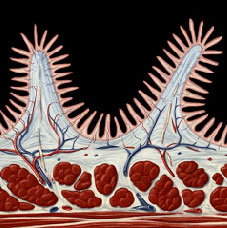| Share |  |
 | |||
Food Allergies: Could They Be Your Problem?
 People often do not make the connection between what they eat and how they feel. Many suffer needlessly from a wide range of health conditions that actually stem from food allergies or sensitivities.
People often do not make the connection between what they eat and how they feel. Many suffer needlessly from a wide range of health conditions that actually stem from food allergies or sensitivities.
In simplest terms, a food allergy is any abnormal response of the immune system to a food (not to be confused with food intolerances caused by lack of enzymes needed to digest a particular food). In this type of reaction, the body mistakes a non-toxic substance as a “foreign invader,” causing the immune system to go on the attack. This begins a process that can eventually produce a wide array of health challenges.
It may seem unlikely that so many different types of symptoms could have the same origin. Yet the latest information points to food allergies (or hypersensitivities as they are sometimes called) as an underlying cause of numerous health conditions on the rise today. Dr. Mark Hyman, a pioneer in functional medicine, says that addressing food allergies and their connection to various ailments, along with proper nutrition, is one of the most powerful ways he helps people recover from nearly any problem.
 A Hidden Menace
A Hidden Menace
This is especially true of a frequently undetected type of food allergy, commonly known as “delayed onset” or IgG mediated immune response. An IgG food allergy is sometimes referred to as food hypersensitivity in order to distinguish it from the classic immediate-onset IgE food allergy. Dr. Theron Randolph, a recognized pioneer of modern allergy research, referred to this type of allergic reaction as “the most common undiagnosed illness in medicine.”
Some sources estimate that as many as 60% of the population is affected in some way by these “delayed” allergies, though they typically are overlooked by most conventionally trained doctors. In fact, the average doctor may not test for or know how to treat this type of allergy. This is likely due to the fact that medications fail to eliminate them as both the cause and the cure are dietary.
Since any one of several systems of the body may be affected in delayed allergies, symptoms run the gamut from a slight rash to an autoimmune disease. In addition, symptoms tend to vary with each individual - what food may cause migraines in one person, could cause irritable bowel syndrome in another.
Not having a clearly defined set of symptoms makes these types of food allergies very difficult to detect, especially when the food allergen is a common one that the person eats several times a day. Since it may take years of repeatedly eating an allergic food for the accumulated damage to produce serious symptoms and disease, the correlation between the food and a person’s symptoms is even less apparent.
Distinguishing Between Classic and Delayed Food Allergies
Delayed-onset food allergies differ in a number of ways from the more familiar classic type of food allergy, known as immediate-onset or IgE mediated allergy. This type of allergy produces a rather dramatic reaction in the body within a couple of hours, or even minutes, after the allergic food is consumed. For instance, if a person eats a food they are allergic to such as peanuts, they could have a reaction that ranges from mild swelling to a phenomenon known as anaphylaxis, in which the throat swells to the point of closing off the air supply.
after the allergic food is consumed. For instance, if a person eats a food they are allergic to such as peanuts, they could have a reaction that ranges from mild swelling to a phenomenon known as anaphylaxis, in which the throat swells to the point of closing off the air supply.
Although this type of allergy is better known, it occurs much less frequently, affecting less than five percent of the population, with most of those being children. It is fairly easy to detect through use of simple skin prick tests, which are generally reliable. The foods people most commonly react to with this type of allergy are: shellfish, peanuts, tree nuts, fish and eggs in adults and milk, eggs, peanuts and tree nuts in children.
Classic immediate-onset allergies produce a reaction every time regardless of how small the amount or how infrequently the food is consumed. On the other hand, a delayed allergic reaction usually involves anywhere from three to ten different common foods eaten by the person repeatedly. In this type of food allergy, how much of the food is eaten and how often it is eaten greatly determines the body’s reaction.
Symptoms of Delayed Food Allergies
Dr. Jonathan Wright and Dr Alan Gaby, who have treated thousands of allergic patients, list the following symptoms in their book, Natural Medicine, Optimal Wellness, as the most commonly experienced ailments and disorders associated with delayed food allergies:
- Migraine and other headaches
- Food cravings
- Obesity/weight gain
- Fluid retention
- Fatigue
- Irritable Bowel Syndrome
- Ulcerative colitis
- Crohn’s disease
- Gallbladder disease
- Arthritis/joint pains
- Asthma
- Chronic bronchitis
- Chronic nasal and sinus congestion
- Recurrent infections
- Bedwetting
- Attention deficit-hyperactivity/learning disorders
- Acne
- Eczema or other skin conditions such as hives, psoriasis or rosacea
- Canker sores
- Mood problems (depression/anxiety)
In addition to these, other conditions frequently reported to be linked with delayed food allergies or sensitivities are:
- Frequent cramps, gas or bloating
- Excess phlegm (mucus)
- Insomnia or sleep apnea
- Brain fog/poor memory and concentration
- Frequent sore throats or ear infections
- Fibromyalgia/migratory muscle and bone pain
- Dark circles or puffiness under eyes

- PMS
- Autism/speech problems
Obviously, many of these conditions have causes unrelated to food allergies. However, if you or someone you know has any of these conditions and they remain unresolved by conventional medical treatment, a food allergy may be the underlying problem. People who do discover the connection between foods and their condition find symptoms dramatically improve and eventually disappear over time when food allergens are eliminated from the diet.
What are the Most Common Food Allergens?
Since they comprise such a major part of the average American diet, wheat (contains the most gluten of all the grains) and dairy (especially milk) are by far the most commonly eaten foods tied to delayed food allergies. Corn, soy, eggs, sugar, and yeast also are among the top allergic foods that frequently produce a delayed allergy response. Certain food additives like artificial colors, preservatives or sulfites cannot be tolerated by many people as well.
Cow’s milk, in particular, is a top delayed food allergen as it is found in popular foods like cheese, ice cream, yogurt, sour cream and butter. It typically causes gas, bloating and other intestinal disturbances.  Food intolerance to milk can occur with people deficient in lactase, the enzyme that breaks down lactose, the sugar in milk. However, a true delayed food allergy response typically stems from casein, the protein in milk.
Food intolerance to milk can occur with people deficient in lactase, the enzyme that breaks down lactose, the sugar in milk. However, a true delayed food allergy response typically stems from casein, the protein in milk.
Pasteurization of milk alters the protein in it, making it difficult to digest. Digestion is further challenged by the fact that dairy products are acidic, which upsets the mineral and pH balance in the body (digestive enzymes cannot function well apart from proper mineral balance – see my article on Understanding pH – Your Health is in the Balance).
In addition to milk, casein is used in processed foods as an extender, tenderizer and protein booster. Different types of caseinate (a form of casein) can be found on the labels of a variety of products such as luncheon meats, imitation sausage, non-dairy cheeses made from soy or rice and even chewing gum!
The Problem of Gluten Sensitivity
Gluten is sticky protein substance that remains after starch is removed from wheat and other cereal grains such as kamut, rye, spelt, triticale, barley, and oats. It allows the dough to rise by trapping gas bubbles given off by yeast, which provides elasticity and texture to the bread. The higher the gluten content, the better bread rises, making its use very popular with manufacturers of bread and baked goods. It is also frequently used in pre-packaged foods as a filler and binder.
 According to the latest research by Kenneth Fine, MD, a renowned gastrointestinal researcher and founder of the Intestinal Health Institute, nearly half of the population has some degree of gluten sensitivity. This may be due to the fact that wheat contains more gluten than the other grains and is so overly used in our food supply. Gluten is believed to be a primary cause of inflammation, associated with weight gain and a host of health issues.
According to the latest research by Kenneth Fine, MD, a renowned gastrointestinal researcher and founder of the Intestinal Health Institute, nearly half of the population has some degree of gluten sensitivity. This may be due to the fact that wheat contains more gluten than the other grains and is so overly used in our food supply. Gluten is believed to be a primary cause of inflammation, associated with weight gain and a host of health issues.
Celiac Disease – the Ultimate Reaction to Gluten
Celiac disease is the most well known of physical conditions stemming from a reaction to gluten and the only one recognized by conventionally trained physicians. Instead of the body producing a reaction by binding directly to the allergen, the body responds to the presence of gluten by attacking itself. Specifically, it attacks the villi (small projections in the lining of the small intestine vital to the absorption of food and nutrients) to the point where nutrients cannot be properly absorbed. Symptoms can vary but usually include fatigue, depression, joint aches, bone pain, gas, bloating, cramping, pain, irritable bowel and diarrhea.
Specifically, it attacks the villi (small projections in the lining of the small intestine vital to the absorption of food and nutrients) to the point where nutrients cannot be properly absorbed. Symptoms can vary but usually include fatigue, depression, joint aches, bone pain, gas, bloating, cramping, pain, irritable bowel and diarrhea.
Once believed to be quite rare, newly developed blood screening tests show celiac disease to be an extremely common gastrointestinal condition, though it remains undiagnosed in many instances. A more recently identified form of celiac known as “silent celiac disease” has been found to create the same type of damage to the small intestine, even when classic gastrointestinal symptoms typically associated with celiac are absent.
On a whole, significant structural damage already takes place in the wall of the small intestine before a diagnosis of celiac disease is made. Only at that time would a doctor instruct the person to avoid all gluten.
However, even before gluten sensitivity reaches the point of a celiac or silent celiac diagnosis, the intestinal irritation and inflammation, coupled with overstimulation of the immune system and nutrient malabsorption, takes its toll on the body, resulting in declining health. Besides damage to the gastrointestinal tract, disorders involving the blood, liver, skin, reproductive and glandular systems occur as well. In fact, a list compiled from published research and presented to the International Symposium on Celiac Disease, brought to light the fact that more than 200 symptoms, complications, or disorders are associated with this condition.
 The Connection of Food Allergies to Weight Gain
The Connection of Food Allergies to Weight Gain
One common condition produced by the body’s response to food allergens is weight gain. As strange as it may sound, people often develop an addiction to the very types of foods to which they are allergic. This is due in part to endorphin-like substances with addictive properties released in the process of an allergic reaction. Endorphins are the “feel good” substances which create a strong desire for more of the food that produced them.
Studies show that “opioid-like” substances found in grains and dairy products, known as exorphins, actually bind to endorphin receptors in the brain. These morphine-like molecules produce a type of “high” whenever that food is consumed. As the temporary feeling wears off, the person tends to crave more of the allergic food.
According to an article on obesity published in the New England Journal of Medicine, when these “opioid-like” substances are consumed in excess, appetite increases and the efficiency of metabolism decreases. In other words, the more you eat that food, the more likely you are to overeat. To make matters more difficult, these same exorphins are thought to cause deficiencies in key neurotransmitters, such as serotonin or dopamine, that affect mood and a sense of well-being.
It is no wonder that a strong physiological, as well as psychological, dependency develops as the person continues to eat the allergic food on a frequent basis. Hence, any attempts to restrict that food are often met with strong cravings, which eventually lead to addictive eating behaviors.
Conclusion
You may wonder, as I did, why everyday foods considered healthy for our body, could cause our immune systems to react in ways that produce such unwelcome symptoms in our bodies. But once you understand what actually takes place during a food allergy reaction and the factors that contribute to their development, the answer to those questions become more apparent.
Next month we will also look at specific causes of food allergies that help answer the question of why they are on the rise today. More importantly, we will learn ways to prevent food allergies from occurring in our children and lessen the likelihood of developing them ourselves as well.
Sources:
- Going Against the Grain by Melissa Diane Smith
- Ultrametabolism by Mark Hyman, MD
- http://www.naturalnews.com/022556_food_allergies_disease.html
- http://www.drbralyallergyrelief.com/igg.html
- http://www.whfoods.com/genpage.php?tname=diet&dbid=7
- http://www.askdrsears.com/html/4/T041800.asp
Copyright © 2008-2015 Lucinda Bedogne, CNHP, CNC
Post Your Comment...
|
|
||||||||||||



